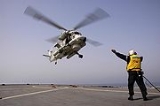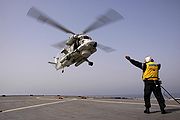
No. 6 Squadron RNZAF
Encyclopedia
No. 6 Squadron Royal New Zealand Air Force
is the squadron operating New Zealand
's navy's air arm. While historically having been disbanded several times through changes in the country's military structure, it has a history going back to before World War II, when it operated flying boats. The squadron motto is “Vigilance with Patience”. Squadron code letters were "XX".
 Following Japan's entry into the war in December 1941, the RNZAF had to switch from primarily training pilots to Europe into a combat force. No. 6 Squadron RNZAF was formed as an army co-operation unit at Milson in February 1942 flying Vickers Vildebeest
Following Japan's entry into the war in December 1941, the RNZAF had to switch from primarily training pilots to Europe into a combat force. No. 6 Squadron RNZAF was formed as an army co-operation unit at Milson in February 1942 flying Vickers Vildebeest
and Hawker Hind
aircraft. At the same time, No. 5 Squadron RNZAF
moved to Fiji with Short Singapores and Vickers Vildebeest
and Vincent biplanes.
Modern maritime patrol flying boats (and more Hudson light bombers) were requested under Lend Lease and when the first Consolidated Catalinas arrived a detachment of men from No. 5 Squadron was assigned to convert to these types as No. 6 Squadron. Before the squadron was officially formed these men successfully completed their first air-sea rescue of a downed US aircrew. From May 1943 No. 6 squadron undertook action against the Japanese. The Squadron also conducted search and rescue missions for allied aircrew and seamen, and undertook many open sea rescues.
After the war No. 6 Squadron was re-equipped with Short Sunderland
flying boats as a territorial unit and also operated float equipped Auster
light aircraft. The Squadron was disbanded in August 1957, with all Sunderlands transferring to No. 5 squadron prior to their replacement by modern P-3 Orion
aircraft.
No. 6 Squadron was reformed in 2005 to take over No.3 Squadron's
role in operating the Royal New Zealand Navy's air element. No. 6 Squadron currently operates New Zealand's five SH-2G(NZ) Seasprite
helicopters. The squadron was re-established on 31 October 2005 by separating the Naval Support Flight from No. 3 Squadron RNZAF
. The Squadron is currently based at RNZAF Base Auckland
.
6 Squadron is manned by Royal New Zealand Navy
Observers. Pilots and Helicopter crewman are drawn from both the Royal New Zealand Navy
and the Royal New Zealand Air Force
. The aircraft are maintained by RNZAF engineers, technicians and suppliers.
Royal New Zealand Air Force
The Royal New Zealand Air Force is the air arm of the New Zealand Defence Force...
is the squadron operating New Zealand
New Zealand
New Zealand is an island country in the south-western Pacific Ocean comprising two main landmasses and numerous smaller islands. The country is situated some east of Australia across the Tasman Sea, and roughly south of the Pacific island nations of New Caledonia, Fiji, and Tonga...
's navy's air arm. While historically having been disbanded several times through changes in the country's military structure, it has a history going back to before World War II, when it operated flying boats. The squadron motto is “Vigilance with Patience”. Squadron code letters were "XX".
History
Vickers Vildebeest
The Vickers Vildebeest and the similar Vickers Vincent were two very large two- to three-seat single-engined British biplanes designed and built by Vickers and used as a light bomber, torpedo bomber and in the army cooperation roles...
and Hawker Hind
Hawker Hind
-See also:-Bibliography:* Crawford, Alex. Hawker Hart Family. Redbourn, Hertfordshire, UK: Mushroom Model Publications Ltd., 2008. ISBN 83-89450-62-3....
aircraft. At the same time, No. 5 Squadron RNZAF
No. 5 Squadron RNZAF
No. 5 Squadron RNZAF is a squadron of the Royal New Zealand Air Force formed during November 1941 in Fiji. It remains on active duty and logged 2,300 hours flight time in 2007.-World War II:...
moved to Fiji with Short Singapores and Vickers Vildebeest
Vickers Vildebeest
The Vickers Vildebeest and the similar Vickers Vincent were two very large two- to three-seat single-engined British biplanes designed and built by Vickers and used as a light bomber, torpedo bomber and in the army cooperation roles...
and Vincent biplanes.
Modern maritime patrol flying boats (and more Hudson light bombers) were requested under Lend Lease and when the first Consolidated Catalinas arrived a detachment of men from No. 5 Squadron was assigned to convert to these types as No. 6 Squadron. Before the squadron was officially formed these men successfully completed their first air-sea rescue of a downed US aircrew. From May 1943 No. 6 squadron undertook action against the Japanese. The Squadron also conducted search and rescue missions for allied aircrew and seamen, and undertook many open sea rescues.
After the war No. 6 Squadron was re-equipped with Short Sunderland
Short Sunderland
The Short S.25 Sunderland was a British flying boat patrol bomber developed for the Royal Air Force by Short Brothers. It took its service name from the town and port of Sunderland in northeast England....
flying boats as a territorial unit and also operated float equipped Auster
Auster
Auster Aircraft Limited was a British aircraft manufacturer from 1938 to 1961.-History:The company began in 1938 at the Britannia Works, Thurmaston near Leicester, England, as Taylorcraft Aeroplanes Limited, making light observation aircraft designed by the Taylorcraft Aircraft Corporation of...
light aircraft. The Squadron was disbanded in August 1957, with all Sunderlands transferring to No. 5 squadron prior to their replacement by modern P-3 Orion
P-3 Orion
The Lockheed P-3 Orion is a four-engine turboprop anti-submarine and maritime surveillance aircraft developed for the United States Navy and introduced in the 1960s. Lockheed based it on the L-188 Electra commercial airliner. The aircraft is easily recognizable by its distinctive tail stinger or...
aircraft.
No. 6 Squadron was reformed in 2005 to take over No.3 Squadron's
No. 3 Squadron RNZAF
3 Squadron is a unit of the RNZAF. It remains on active duty.-History:No. 3 Squadron RNZAF formed as a Territorial unit of the New Zealand Permanent Air Force based at Christchurch in 1930....
role in operating the Royal New Zealand Navy's air element. No. 6 Squadron currently operates New Zealand's five SH-2G(NZ) Seasprite
SH-2 Seasprite
The Kaman SH-2 Seasprite is a ship-based helicopter with anti-submarine, anti-surface threat capability, including over-the-horizon targeting. This aircraft extends and increases shipboard sensor and weapon capabilities against several types of enemy threats, including submarines of all types,...
helicopters. The squadron was re-established on 31 October 2005 by separating the Naval Support Flight from No. 3 Squadron RNZAF
No. 3 Squadron RNZAF
3 Squadron is a unit of the RNZAF. It remains on active duty.-History:No. 3 Squadron RNZAF formed as a Territorial unit of the New Zealand Permanent Air Force based at Christchurch in 1930....
. The Squadron is currently based at RNZAF Base Auckland
RNZAF Base Auckland
RNZAF Base Auckland is a Royal New Zealand Air Force base located near the upper reaches of the Waitemata Harbour in Auckland, New Zealand. The base formerly comprised two separate airfields, Whenuapai and Hobsonville. Hobsonville was established as a seaplane station in 1928 and was the RNZAF's...
.
6 Squadron is manned by Royal New Zealand Navy
Royal New Zealand Navy
The Royal New Zealand Navy is the maritime arm of the New Zealand Defence Force...
Observers. Pilots and Helicopter crewman are drawn from both the Royal New Zealand Navy
Royal New Zealand Navy
The Royal New Zealand Navy is the maritime arm of the New Zealand Defence Force...
and the Royal New Zealand Air Force
Royal New Zealand Air Force
The Royal New Zealand Air Force is the air arm of the New Zealand Defence Force...
. The aircraft are maintained by RNZAF engineers, technicians and suppliers.

